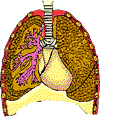Sign up for FlowVella
Sign up with FacebookAlready have an account? Sign in now
By registering you are agreeing to our
Terms of Service
Loading Flow

How does this system interact with other systems?
Skeletal System: bones provide calcium that is essential for proper functioning of the nervous system.
The skull protects the brain from injury.
The vertebrate protects the spinal cord from injury.
The brain regulates the position of the bones by controlling muscles.
Muscular system: receptors in muscles provide the brain with information about the body's position and movement.
The brain controls contraction of skeletal muscles.
Lymphatic system: the brain stimulates defense mechanisms to fight against infection.
Cardiovascular system: endothelial cells maintains the blood brain barrier. Baroreceptors send information to the brain about blood pressure. The brain regulates heart rate and blood pressure.
Respiratory System:
The brain monitors respiratory volume and blood gas level, and the brain regulates respiratory rate.
Digestive system: digestive process provide the building blocks for some neurotransmitters. The autonomic nervous system controls the tone of the digestive track. The brain controls drinking and feeding behaviors.
Reproductive system: reproductive hormones affect brain development and sexual behavior.






